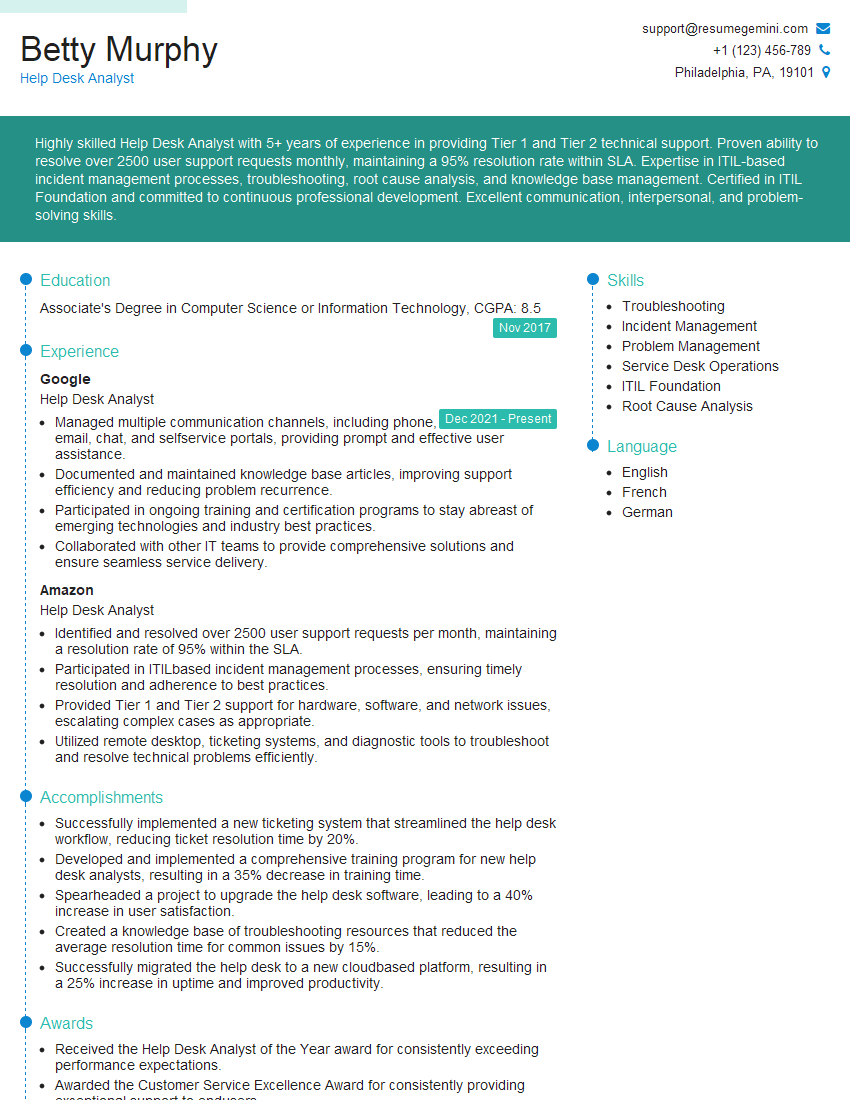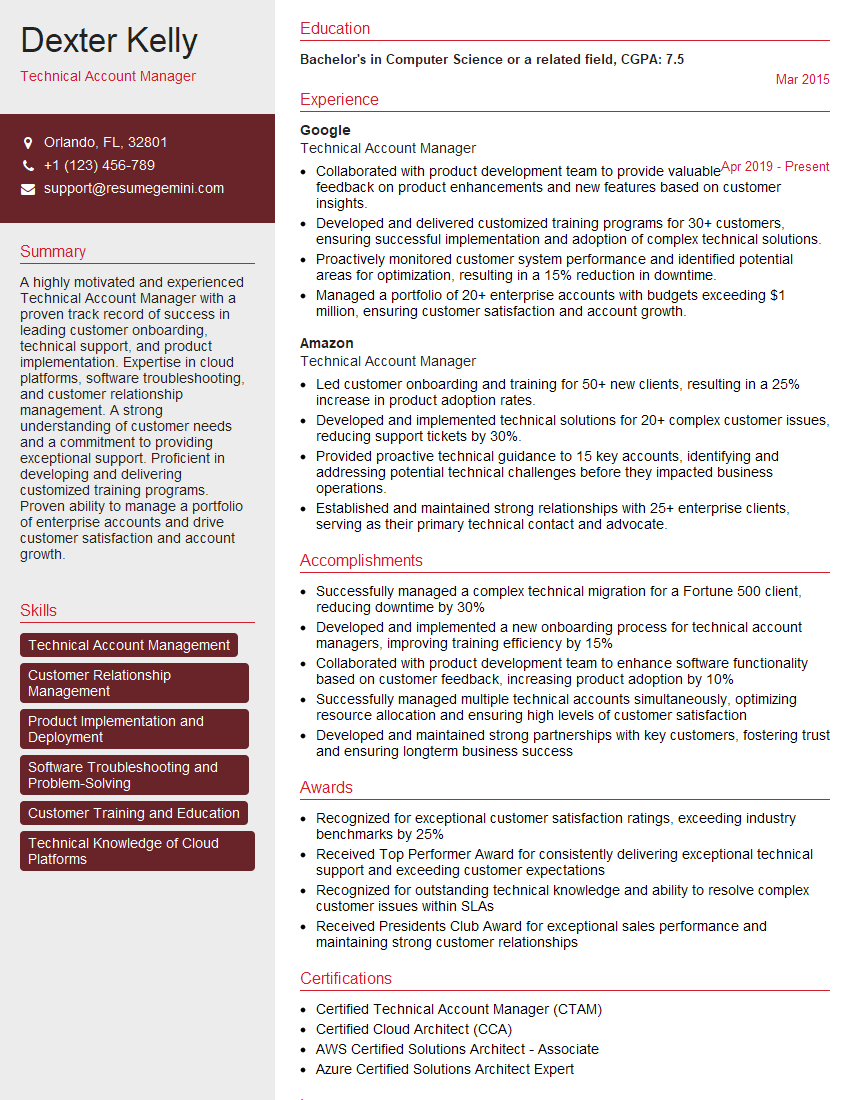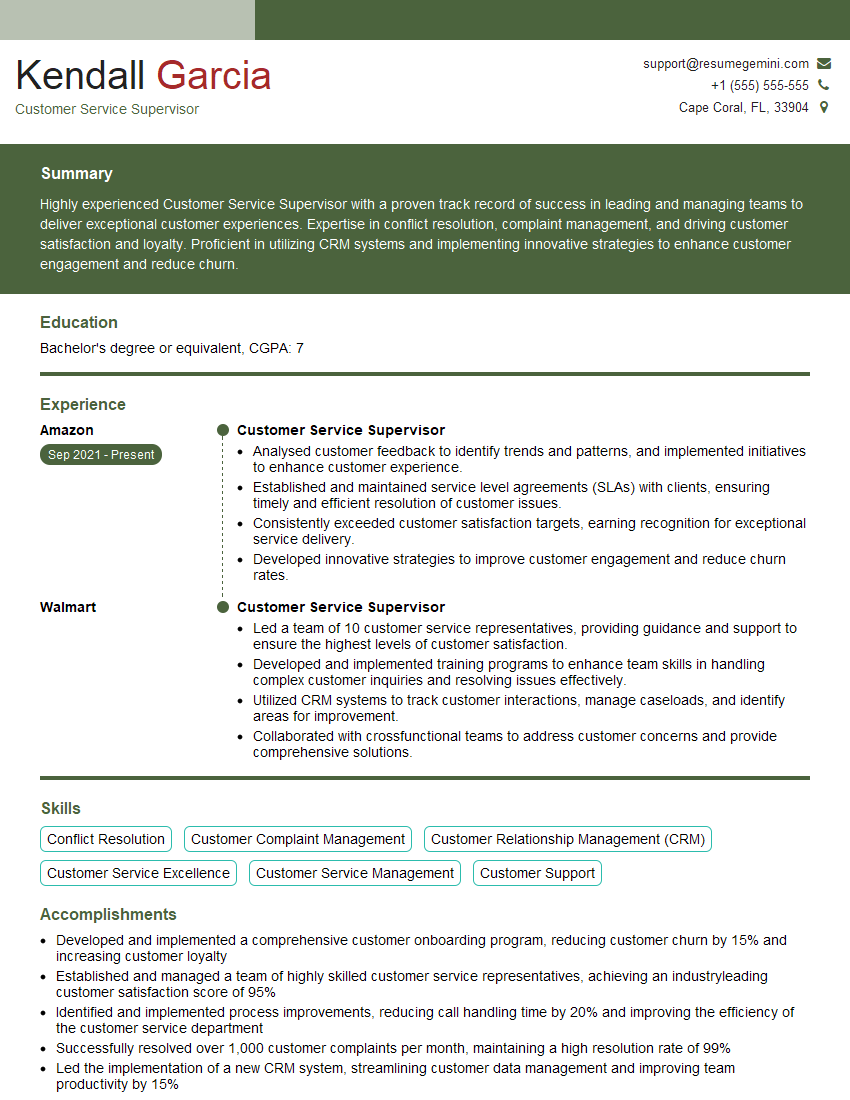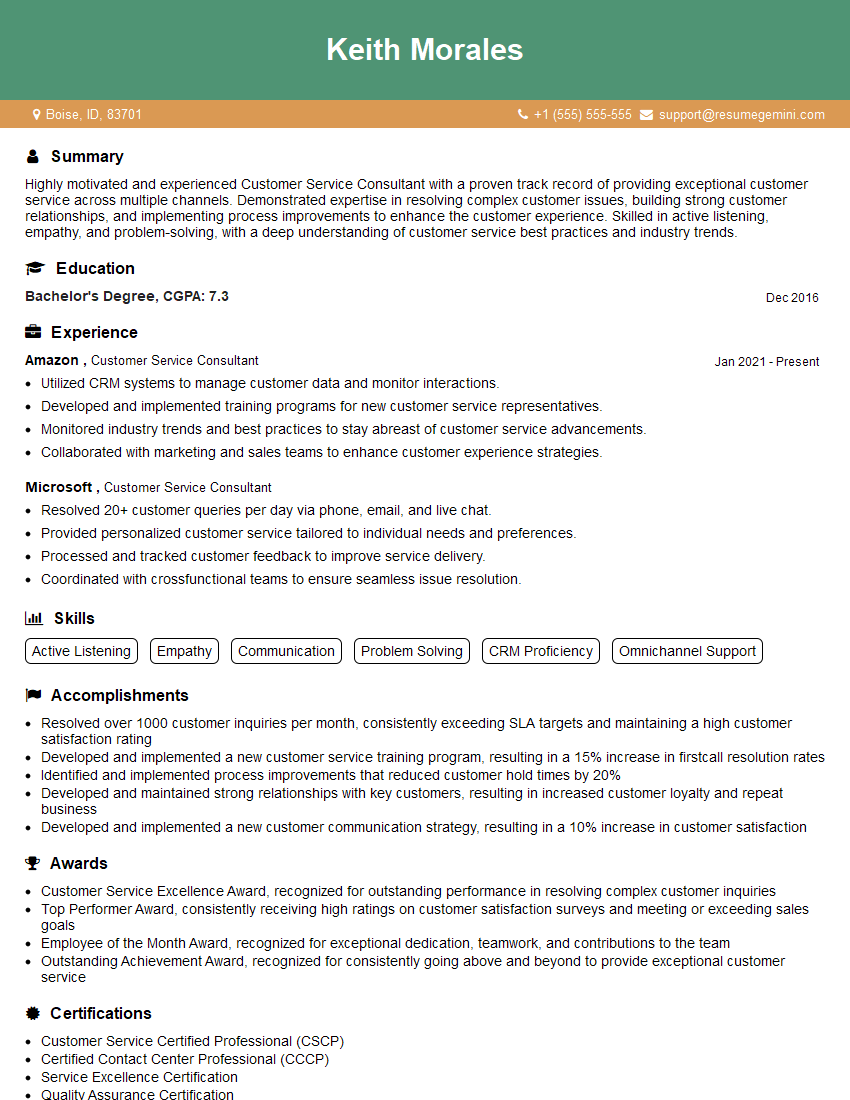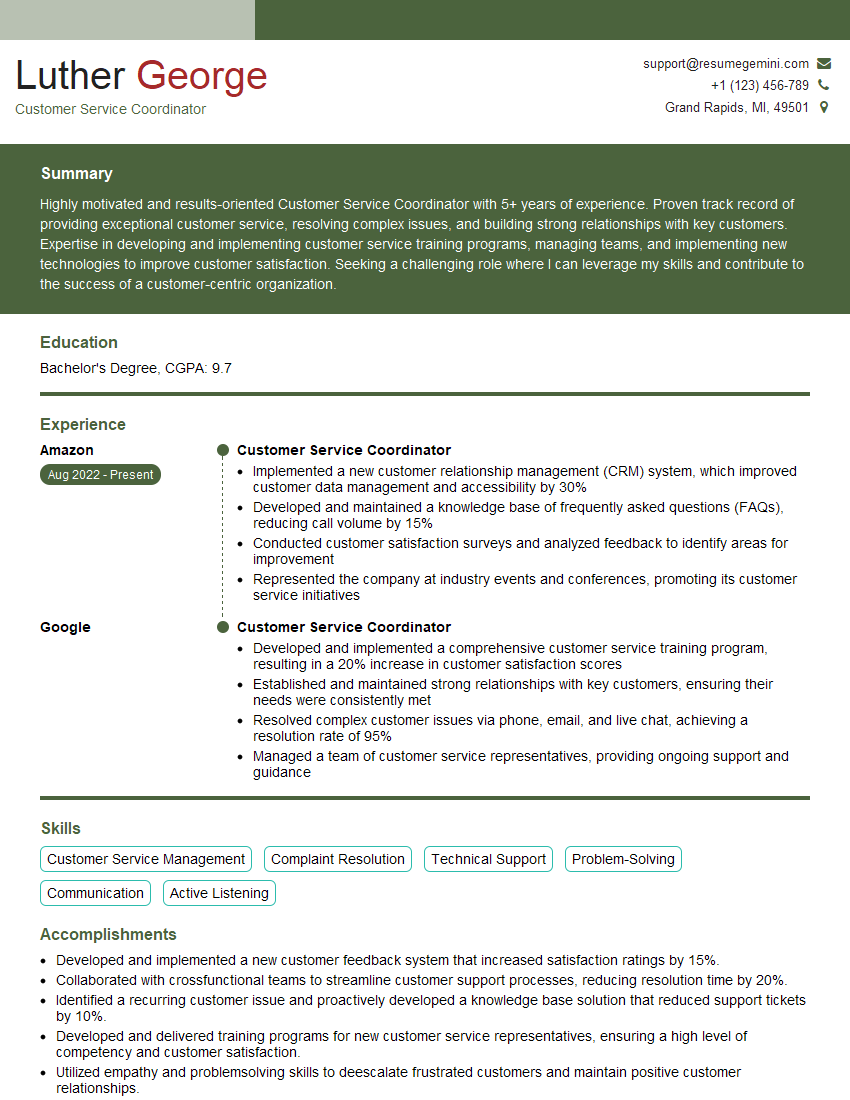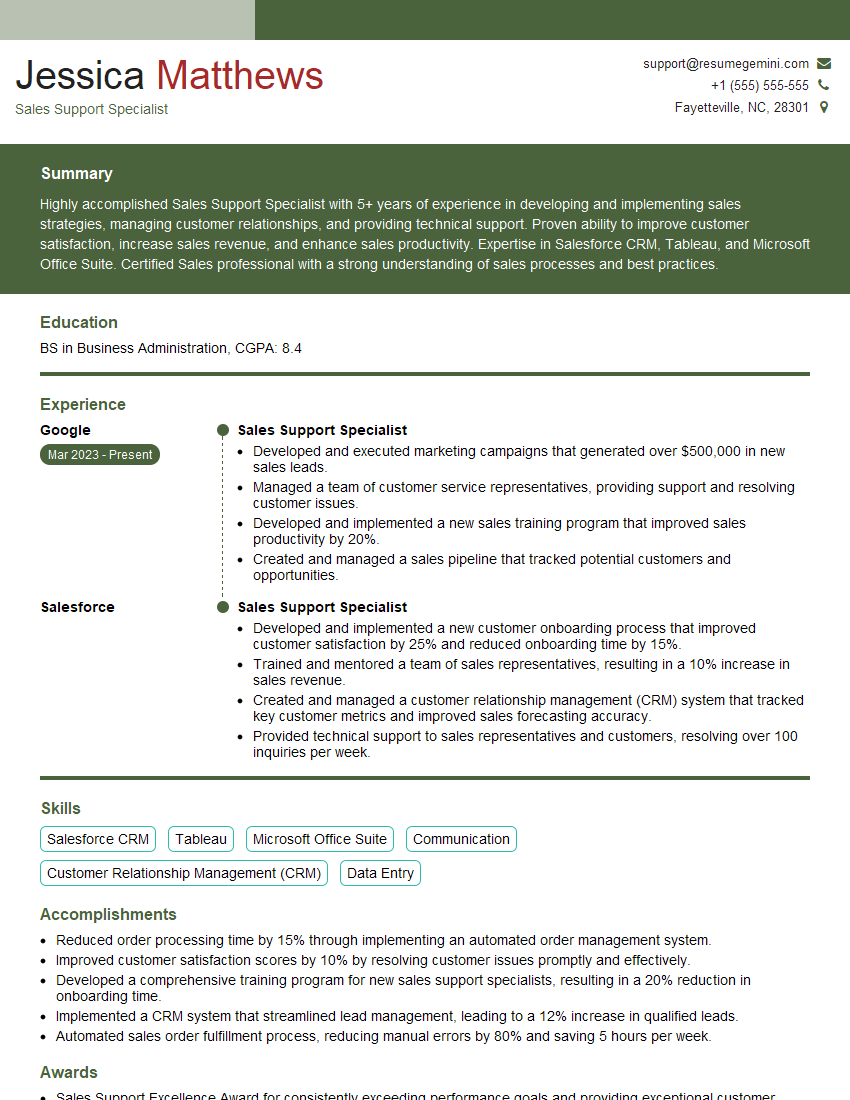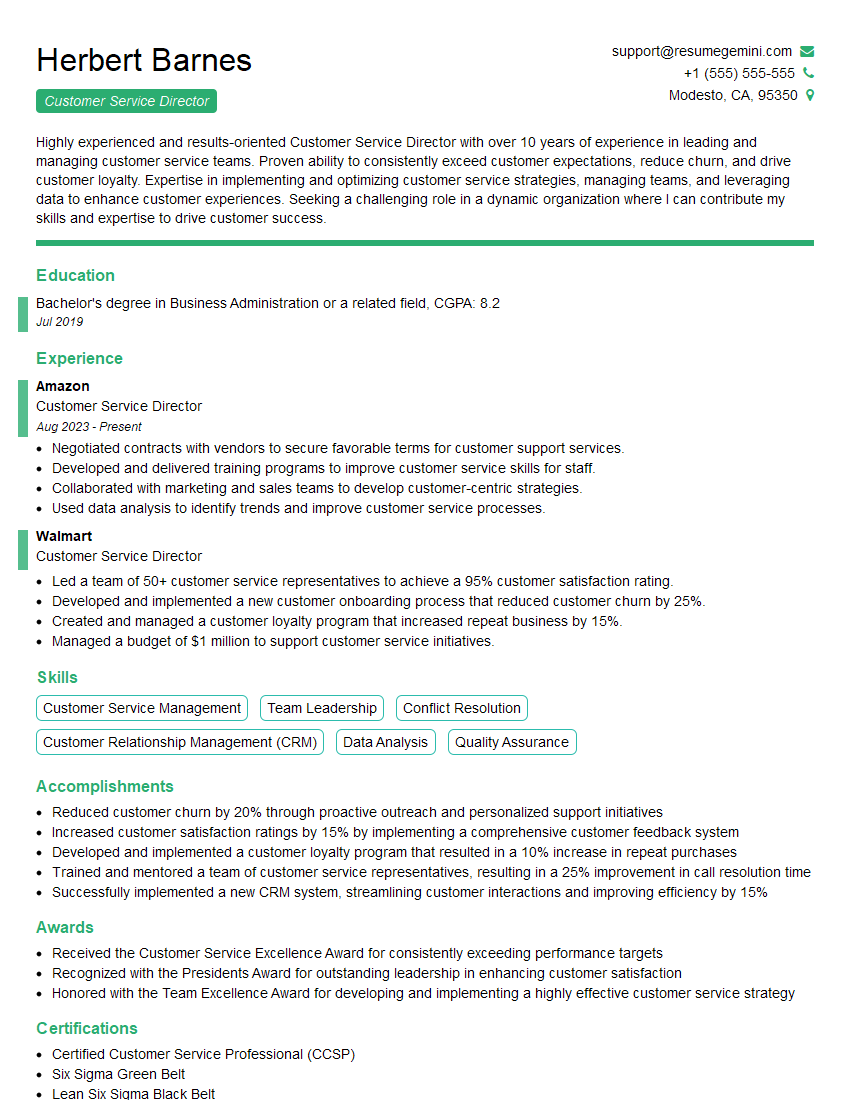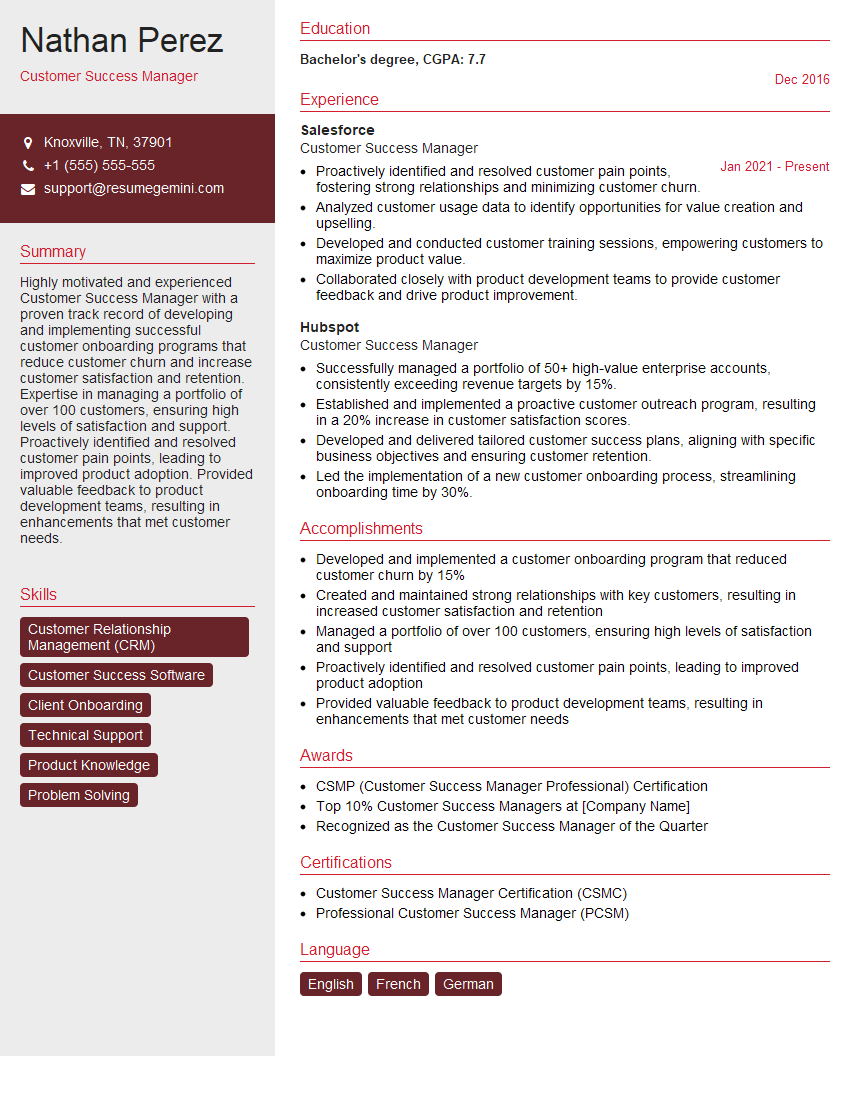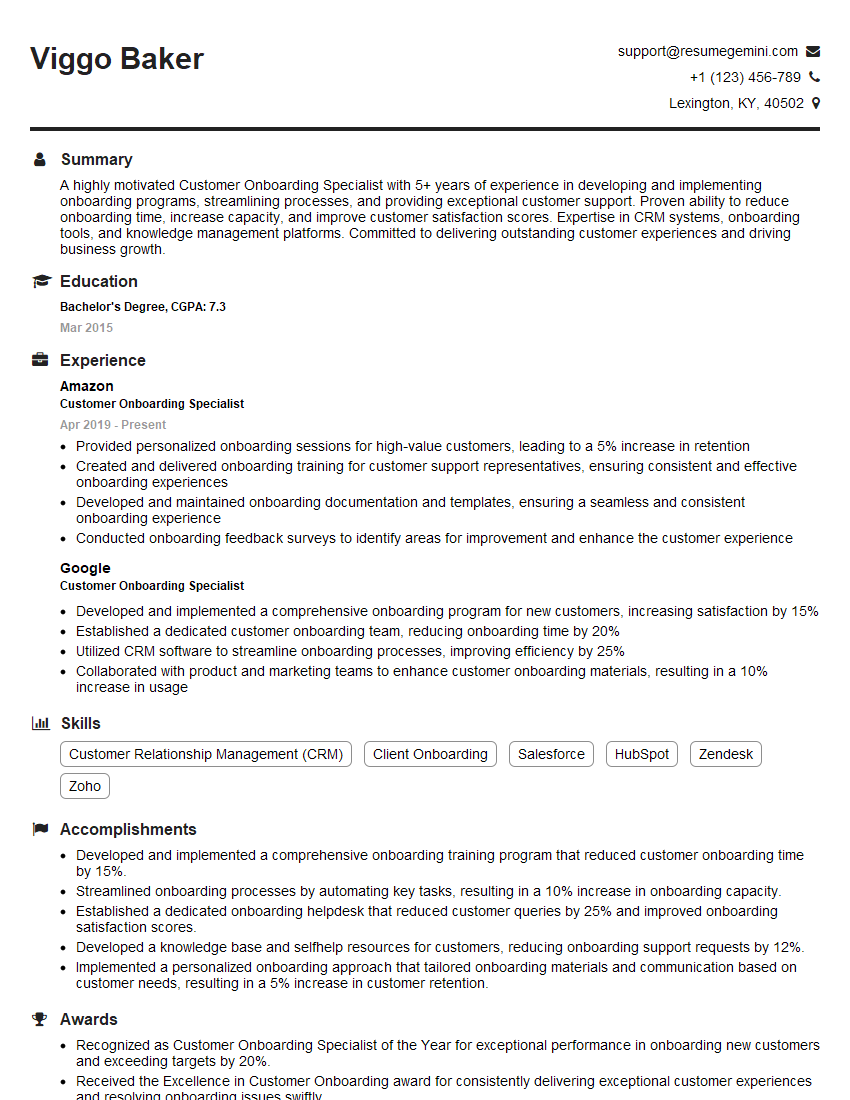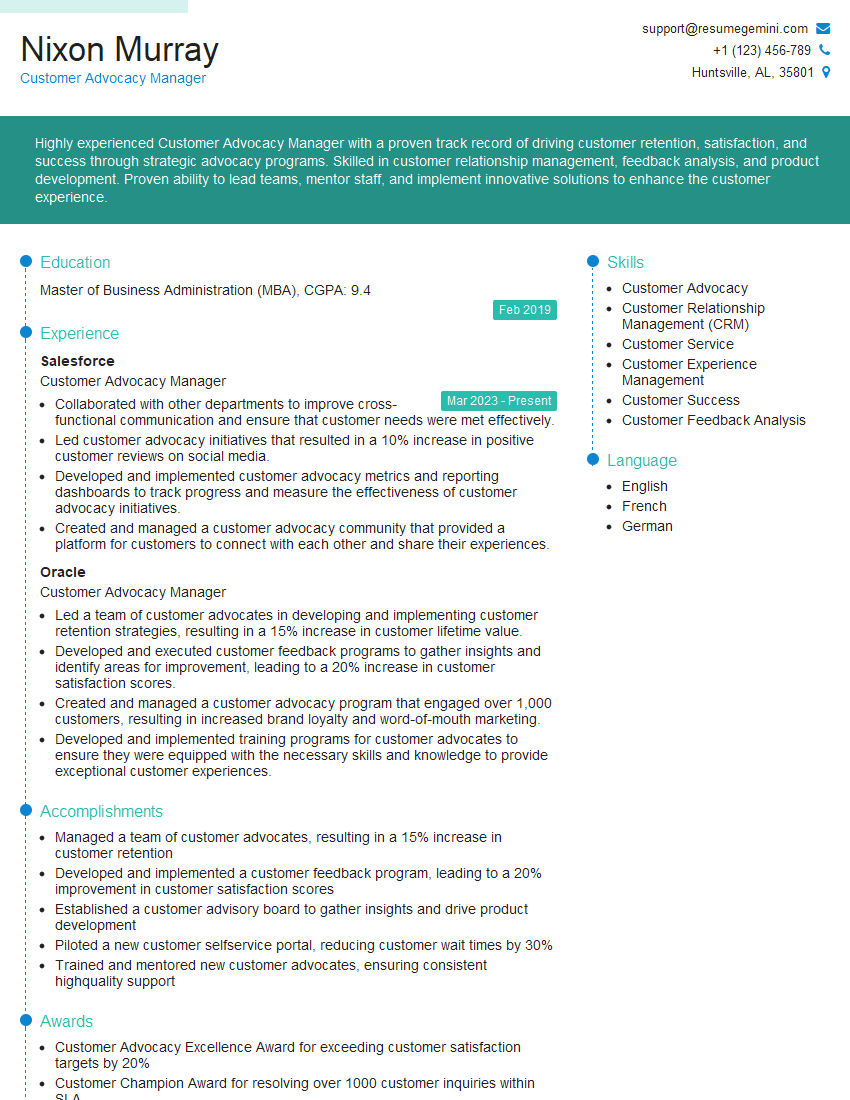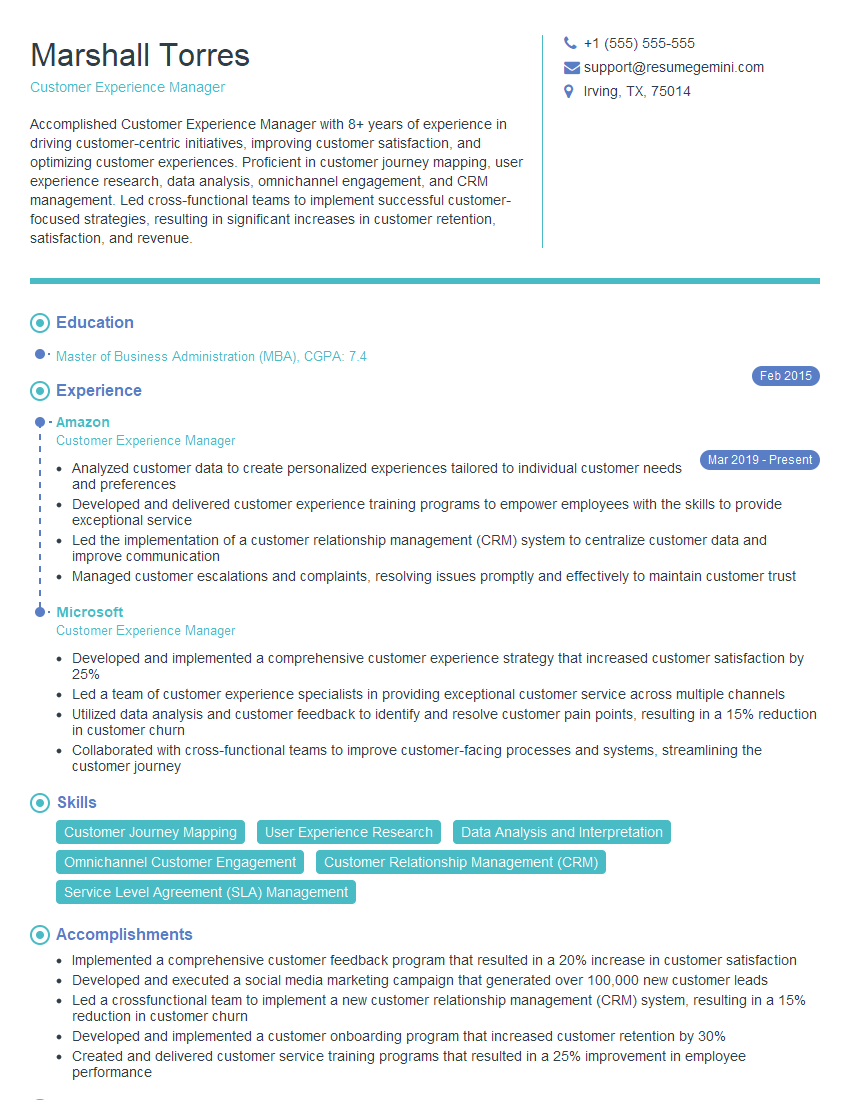Feeling uncertain about what to expect in your upcoming interview? We’ve got you covered! This blog highlights the most important Certified Customer Service Professional (CCSP) interview questions and provides actionable advice to help you stand out as the ideal candidate. Let’s pave the way for your success.
Questions Asked in Certified Customer Service Professional (CCSP) Interview
Q 1. Describe your understanding of the CCSP certification and its core competencies.
The Certified Customer Service Professional (CCSP) certification signifies a high level of expertise in providing exceptional customer service. It’s not just about politeness; it’s about mastering the skills and knowledge needed to consistently exceed customer expectations and build strong, lasting relationships. The core competencies typically encompass several key areas:
- Communication Skills: This includes active listening, clear and concise verbal and written communication, and effective questioning techniques to understand customer needs.
- Problem-Solving and Conflict Resolution: CCSP professionals are adept at identifying the root cause of customer issues, developing effective solutions, and de-escalating tense situations with diplomacy and empathy.
- Customer Relationship Management (CRM): Understanding and utilizing CRM systems to track interactions, manage customer data, and personalize service is crucial.
- Product and Service Knowledge: A deep understanding of the products or services offered allows for accurate and efficient problem-solving.
- Ethics and Professionalism: Maintaining a high level of integrity and professionalism in all interactions is paramount.
- Empathy and Emotional Intelligence: Understanding and responding to the emotional needs of customers is essential for building trust and loyalty.
Essentially, the CCSP certification validates an individual’s ability to deliver consistently excellent customer experiences, leading to increased customer satisfaction and loyalty.
Q 2. Explain the importance of active listening in customer service interactions.
Active listening is paramount in customer service. It’s more than just hearing what a customer says; it’s about truly understanding their perspective, concerns, and emotions. It involves paying close attention not only to their words but also to their tone of voice and body language. This understanding enables you to provide a more tailored and effective response.
For example, imagine a customer calling about a delayed shipment. Instead of immediately jumping to solutions, an active listener would first fully understand the customer’s frustration: Why is the delay causing such concern? Are they missing a deadline? What are the potential consequences? By showing empathy and truly grasping the situation, you can then offer more appropriate support and build rapport.
Techniques for active listening include maintaining eye contact (if in-person or video call), summarizing the customer’s points to confirm understanding (‘So, if I understand correctly, you’re frustrated because…’), and asking clarifying questions (‘Can you tell me more about…’). This demonstrates genuine care and builds trust, making the customer feel heard and valued.
Q 3. How do you handle difficult or irate customers?
Handling difficult or irate customers requires a calm, empathetic, and structured approach. The goal is to de-escalate the situation and find a mutually agreeable resolution. Here’s a step-by-step approach:
- Listen Empathetically: Let the customer vent without interruption (unless the language becomes abusive or threatening). Show that you understand their frustration.
- Validate their Feelings: Acknowledge their emotions. Phrases like ‘I understand your frustration,’ or ‘I can see why you’re upset’ can be powerful.
- Apologize Sincerely: Even if the situation isn’t entirely your fault, apologize for the inconvenience or negative experience. This doesn’t mean admitting guilt, but it shows empathy.
- Take Ownership (Where Appropriate): If your team is at fault, own it. Avoid making excuses.
- Offer Solutions: Present clear, concise solutions to address the customer’s problem. Involve them in the solution-finding process where appropriate.
- Follow Up: After resolving the issue, follow up to ensure the customer is satisfied and to show that you value their business.
Remember, maintaining your composure is key. If the situation becomes unmanageable, involve a supervisor or manager for support.
Q 4. What are some common customer service challenges, and how have you addressed them?
Common customer service challenges include long wait times, unclear communication, technical difficulties, product defects, and billing errors. I’ve addressed these challenges by:
- Improving processes: Implementing streamlined processes to reduce wait times and improve efficiency. For example, I’ve worked on improving call routing and self-service options.
- Enhancing communication: Using clear, concise language, providing regular updates, and offering multiple communication channels (email, phone, chat). I’ve helped create more user-friendly documentation and FAQs.
- Proactive problem solving: Utilizing CRM data to identify recurring issues and develop proactive solutions. This might include improving product design or training staff to handle specific issues more efficiently.
- Empowering employees: Empowering front-line staff to resolve issues independently and providing them with the necessary training and resources. This increases responsiveness and customer satisfaction.
- Seeking continuous improvement: Regularly evaluating customer feedback and analyzing metrics (such as customer satisfaction scores and resolution times) to identify areas for improvement.
Addressing these challenges requires a multifaceted approach that combines process improvements, training, and a commitment to continuous improvement.
Q 5. Describe your experience with conflict resolution in customer service settings.
Conflict resolution in customer service often involves mediating disputes between customers and the company or between customers and other individuals. My experience involves using several key techniques:
- Active Listening and Empathy: Understanding both parties’ perspectives is crucial. I ensure both sides feel heard and understood.
- Neutral Facilitation: I act as a neutral mediator, guiding the conversation towards a solution without taking sides.
- Identifying the Root Cause: Uncovering the underlying cause of the conflict is critical to finding a lasting solution. This might involve uncovering miscommunication or a misunderstanding of policies.
- Brainstorming Solutions: Working collaboratively with both parties to generate potential solutions. This makes them feel involved and invested in the process.
- Documenting the Resolution: Keeping a detailed record of the conflict and the agreed-upon resolution is essential.
For example, I once mediated a dispute between a customer and a technician regarding a repair. By actively listening to both sides and clarifying misunderstandings, I helped them reach a mutually acceptable solution that avoided further escalation.
Q 6. How do you prioritize multiple customer requests simultaneously?
Prioritizing multiple customer requests simultaneously requires a strategic approach. I typically use a combination of techniques:
- Urgency and Importance: I assess each request based on its urgency (how quickly it needs to be addressed) and importance (its impact on the customer and the business). Requests are categorized using a matrix (e.g., high urgency/high importance, low urgency/low importance).
- Time Management: Effective time management is crucial. Techniques such as time blocking and task prioritization help to allocate time efficiently.
- Multitasking (Strategically): While multitasking can be detrimental, strategically switching between tasks—especially those with shorter completion times—can improve overall efficiency.
- Communication: Keeping customers informed about estimated wait times helps manage expectations and reduces frustration. Transparency builds trust.
- Technology: Using CRM systems and other tools to track requests, manage workflows, and ensure no request falls through the cracks.
This prioritization process ensures that the most critical requests are addressed promptly while maintaining a balance between all customers’ needs.
Q 7. What strategies do you employ to build rapport with customers?
Building rapport with customers is about establishing a connection and creating a positive interaction. I employ several strategies:
- Personalization: Addressing customers by name, using their preferred communication method, and personalizing interactions whenever possible helps build a connection.
- Active Listening and Empathy: Truly listening to the customer’s concerns and demonstrating understanding creates a sense of trust and connection.
- Positive and Professional Demeanor: Maintaining a positive and professional attitude, even during challenging interactions, fosters trust and goodwill.
- Clear and Concise Communication: Using clear and concise language avoids misunderstandings and confusion, enhancing the customer experience.
- Finding Common Ground: Identifying shared interests or experiences, where appropriate and professional, can help establish a connection.
- Showing Appreciation: Expressing gratitude for the customer’s business reinforces the value of their patronage.
Building rapport is an ongoing process that requires consistency and genuine care. It’s about creating a positive lasting impression that encourages customer loyalty.
Q 8. Explain your experience with CRM software and its application in customer service.
My experience with CRM software is extensive, encompassing several leading platforms like Salesforce, Zendesk, and HubSpot. I’ve utilized these systems not just for basic contact management but for strategically improving customer service. A CRM’s strength lies in its ability to centralize customer information – interaction history, purchase details, preferences, and support tickets – creating a 360-degree view of each customer. This holistic view is critical for personalized service.
For instance, in a previous role using Salesforce, I leveraged the platform’s case management features to track customer inquiries, ensuring timely resolutions and follow-ups. The system’s reporting capabilities allowed me to analyze trends in customer issues, identify areas needing improvement, and proactively address potential problems before they escalated. Furthermore, I utilized Salesforce’s automation features to streamline repetitive tasks, freeing up time for more complex customer interactions and personalized outreach.
Beyond case management, CRMs help me segment customers based on various criteria (purchase history, engagement level, demographics), enabling targeted marketing campaigns and personalized support strategies. This tailored approach enhances customer satisfaction and fosters loyalty.
Q 9. How do you effectively gather and document customer information?
Gathering and documenting customer information is paramount for providing efficient and effective service. My approach prioritizes accuracy and completeness while respecting customer privacy. I employ a multi-faceted strategy:
- Active Listening and Clarifying Questions: I begin by actively listening to understand the customer’s needs completely. I use clarifying questions to confirm understanding and gather all relevant details.
- Structured Forms and Templates: Where appropriate, I use pre-defined forms or templates to ensure consistent and comprehensive data collection. This guarantees essential information is captured consistently across all interactions.
- CRM Integration: I meticulously record all interactions, including customer details, issue descriptions, resolutions, and follow-up actions, within the CRM system. This centralizes information and provides an auditable trail.
- Note-Taking and Summarization: For less structured conversations, I take detailed notes during the call or interaction, summarizing key points and actions afterward. I ensure my notes are concise, accurate, and easily accessible.
- Privacy and Security: I adhere strictly to data privacy regulations (e.g., GDPR, CCPA), ensuring customer information is handled securely and ethically. I only collect necessary data and obtain consent where required.
Think of it like building a customer profile – the more accurate and detailed the information, the better equipped I am to understand and address their needs effectively.
Q 10. Describe your approach to providing effective and empathetic customer service.
Providing effective and empathetic customer service is about more than just resolving issues; it’s about building relationships. My approach combines efficient problem-solving with genuine compassion. I start by acknowledging the customer’s feelings and validating their experience, showing I understand their frustration or concern. I actively listen, reflecting their emotions before offering solutions.
For example, if a customer is upset about a delayed order, I might say: “I understand your frustration with the delay; I would be upset too. Let’s work together to find a solution.” This empathetic approach establishes rapport and makes the customer feel heard and valued. Then, I systematically investigate the problem, keeping the customer informed every step of the way. I focus on finding the best solution, not just the easiest. This might involve going the extra mile – offering a discount, expedited shipping, or a personalized apology – to demonstrate commitment to their satisfaction.
Effective and empathetic service is a continuous process; it’s about understanding the individual’s unique needs and providing tailored support. It’s about turning a negative experience into a positive interaction, fostering loyalty and advocacy.
Q 11. How do you identify and escalate critical customer issues?
Identifying and escalating critical customer issues requires a keen understanding of the business’s priorities and the potential impact on customers. I use a multi-step approach:
- Prioritization based on Impact and Urgency: I assess each issue based on its severity and urgency. Factors considered include financial impact, reputation damage, legal implications, and customer safety.
- Clear Escalation Procedures: I follow established escalation procedures, documenting the issue, its severity, and the steps taken to address it. This ensures a clear communication trail for all involved parties.
- Effective Communication: I communicate promptly and clearly with relevant stakeholders, such as supervisors, technical support, or management, providing all necessary information for appropriate action.
- Regular Follow-up: I follow up regularly on escalated issues, ensuring timely resolution and keeping the customer informed of the progress.
- Documentation and Reporting: I maintain thorough documentation of all escalated issues, including resolution outcomes and lessons learned, to improve future processes.
For example, a security breach affecting customer data would be immediately escalated to the highest level of management, requiring immediate action and comprehensive reporting. Less critical but still important issues might follow a less urgent escalation path.
Q 12. How do you maintain professionalism under pressure in demanding customer service situations?
Maintaining professionalism under pressure in demanding situations is a crucial skill for customer service professionals. My approach relies on several key strategies:
- Deep Breaths and Pause: Before responding, I take a moment to compose myself, taking deep breaths to manage stress and avoid impulsive reactions.
- Active Listening and Empathy: Focusing on actively listening and empathizing with the customer helps de-escalate tensions and shift the focus from conflict to resolution.
- Clear and Concise Communication: I communicate clearly and concisely, avoiding jargon or overly technical language. I speak calmly and professionally, even when faced with aggressive or abusive customers.
- De-escalation Techniques: I utilize de-escalation techniques, such as acknowledging the customer’s feelings and repeating their concerns to show I understand their perspective.
- Seeking Support: When needed, I don’t hesitate to seek support from supervisors or colleagues, particularly in situations that are beyond my scope or require specialized expertise.
Remember, keeping calm and professional projects an image of competence and control, even when the situation is challenging. It helps diffuse the customer’s anger and enables a more productive resolution.
Q 13. How do you handle customer complaints and feedback effectively?
Handling customer complaints and feedback effectively requires a proactive and solution-oriented approach. I follow these steps:
- Active Listening and Validation: I actively listen to the customer’s complaint, acknowledging their feelings and validating their experience. This demonstrates empathy and builds rapport.
- Gather Information: I gather all relevant information to understand the issue thoroughly, asking clarifying questions and avoiding interruptions.
- Apologize Sincerely: Even if the issue isn’t entirely my fault, I offer a sincere apology for the inconvenience or frustration caused.
- Propose a Solution: I propose a solution tailored to the customer’s needs, whether it’s a refund, replacement, repair, or other appropriate action.
- Follow Up: I follow up with the customer to ensure they are satisfied with the resolution and address any remaining concerns.
- Feedback Analysis: I analyze customer feedback to identify trends and patterns that can be used to improve products, services, or processes.
For instance, if a customer complains about a faulty product, I’d apologize for the inconvenience, offer a replacement or refund, and investigate the cause of the fault to prevent similar issues in the future. The goal is to turn a negative experience into an opportunity for improvement and strengthened customer loyalty.
Q 14. What metrics do you use to measure the effectiveness of your customer service efforts?
Measuring the effectiveness of customer service efforts is crucial for continuous improvement. I utilize a range of metrics, categorized for clarity:
- Customer Satisfaction (CSAT): This measures how satisfied customers are with their service experience, often through surveys or feedback forms.
- Customer Effort Score (CES): This assesses how easy it was for customers to resolve their issues. A lower score indicates greater ease and efficiency.
- Net Promoter Score (NPS): This measures customer loyalty and willingness to recommend the company to others.
- First Call Resolution (FCR): This tracks the percentage of customer issues resolved on the first contact, indicating efficiency and effectiveness.
- Average Handling Time (AHT): This measures the average time spent resolving customer issues, helping identify areas for process improvement.
- Resolution Time: This indicates the time taken from issue report to resolution, highlighting speed and responsiveness.
- Customer Churn Rate: Tracking customer loss can pinpoint issues that lead to dissatisfaction and disloyalty.
By regularly monitoring and analyzing these metrics, I can identify areas needing improvement and implement changes to enhance customer service effectiveness. It is crucial to consider the interplay of these metrics rather than focusing on single ones in isolation.
Q 15. Explain your understanding of customer service quality assurance processes.
Customer service quality assurance (QA) processes are crucial for ensuring consistent, high-quality interactions with customers. These processes involve systematic monitoring, measurement, and improvement of customer service activities. Think of it like a quality control check for a factory – except instead of products, we’re evaluating customer experiences.
A robust QA process typically includes several key steps:
- Defining Service Level Agreements (SLAs): Setting clear, measurable targets for things like response times, resolution rates, and customer satisfaction (CSAT) scores.
- Monitoring Interactions: Utilizing various methods such as call recordings, email reviews, chat transcripts, and social media monitoring to assess agent performance and identify areas for improvement. This allows for identification of trends and recurring issues.
- Performance Measurement: Quantifying key performance indicators (KPIs) like average handling time (AHT), first call resolution (FCR), customer satisfaction (CSAT), and Net Promoter Score (NPS). These metrics provide data-driven insights into customer service effectiveness.
- Feedback Collection: Actively seeking feedback from customers through surveys, feedback forms, and post-interaction follow-ups. This provides direct insights into the customer perspective.
- Coaching and Training: Using the data and feedback gathered to identify training needs for agents and implement targeted training programs to address skill gaps and improve performance.
- Process Improvement: Continuously analyzing the QA data to identify bottlenecks, inefficiencies, and areas for process optimization. This iterative process ensures that customer service constantly adapts and improves.
For example, if our CSAT scores are consistently low after phone interactions, we might analyze call recordings to pinpoint the source of the issue. Perhaps agents are not actively listening to customer concerns, or they are not providing clear and concise solutions. Based on this analysis, we might implement additional training on active listening and solution-oriented communication.
Career Expert Tips:
- Ace those interviews! Prepare effectively by reviewing the Top 50 Most Common Interview Questions on ResumeGemini.
- Navigate your job search with confidence! Explore a wide range of Career Tips on ResumeGemini. Learn about common challenges and recommendations to overcome them.
- Craft the perfect resume! Master the Art of Resume Writing with ResumeGemini’s guide. Showcase your unique qualifications and achievements effectively.
- Don’t miss out on holiday savings! Build your dream resume with ResumeGemini’s ATS optimized templates.
Q 16. How do you stay updated on best practices in customer service?
Staying updated on customer service best practices is essential in today’s rapidly evolving landscape. I employ a multi-faceted approach to ensure I remain current:
- Industry Publications and Blogs: I regularly read publications and blogs focused on customer service, such as those from leading customer experience (CX) firms. This provides me with insights into industry trends, emerging technologies, and successful strategies.
- Conferences and Webinars: Attending industry conferences and webinars allows me to network with other professionals and learn from experts in the field. This firsthand experience is invaluable.
- Professional Certifications: Pursuing certifications like the CCSP keeps me up-to-date with the latest industry standards, best practices, and methodologies. This formal recognition demonstrates a commitment to ongoing learning.
- Online Courses and Learning Platforms: I utilize online learning platforms such as Coursera and LinkedIn Learning to access relevant courses and stay abreast of new developments. This helps me continuously improve my skills and knowledge.
- Networking: Actively participating in online and offline communities provides valuable opportunities to share knowledge and learn from others’ experiences. This collaborative learning environment is very beneficial.
For example, I recently attended a webinar on the use of AI-powered chatbots to improve customer service efficiency. I’m now exploring how to implement similar solutions in my own work setting.
Q 17. Describe your experience with different customer service channels (phone, email, chat, etc.).
I possess extensive experience across various customer service channels, understanding the nuances and best practices for each. Each channel requires a different approach and skill set.
- Phone: Strong communication, active listening, empathy, and the ability to build rapport are critical for phone support. I’m adept at handling complex issues and providing clear, concise solutions over the phone.
- Email: Writing clear, professional emails, managing multiple conversations simultaneously, and maintaining consistent response times are crucial. I prioritize providing well-organized, detailed responses that effectively address customer concerns.
- Chat: Quick response times, concise communication, and the ability to handle multiple chats concurrently are essential. I use chat features efficiently, to resolve inquiries quickly and effectively.
- Social Media: Responding promptly and professionally to public inquiries, addressing concerns publicly or privately depending on the sensitivity, and managing the company’s online reputation are critical. I understand the importance of maintaining a positive brand image.
In one instance, a frustrated customer contacted us via email regarding a faulty product. Through detailed email correspondence, I was able to diagnose the issue, arrange for a replacement product, and even provide a small discount to compensate for the inconvenience. This demonstrated our commitment to customer satisfaction and resulted in a positive resolution.
Q 18. How do you personalize the customer service experience?
Personalizing the customer service experience is key to building strong customer relationships and fostering loyalty. It involves tailoring interactions to meet individual customer needs and preferences. This goes beyond simply using a customer’s name.
- Using Customer Data: Leveraging CRM systems to access customer history, purchase patterns, and past interactions allows for more informed and personalized service. Knowing a customer’s past interactions helps tailor the solution to their specific situation.
- Proactive Service: Anticipating customer needs based on past interactions or known preferences allows for proactive outreach and problem resolution before issues arise. For example, sending a reminder email about an upcoming product renewal.
- Tailored Communication: Adjusting communication style to match the customer’s preferred method and tone. Some prefer formal communication, while others prefer a more casual approach.
- Personalized Recommendations: Offering product recommendations or services based on past purchases or browsing history. This adds value to the customer interaction.
- Remembering Details: Remembering details from past interactions, such as preferences or specific situations, shows customers that they are valued and understood.
For example, I once remembered a customer’s preference for a specific brand of coffee from a past order when resolving an issue with their recent purchase. This small detail made the interaction more personal and improved their overall experience.
Q 19. How do you use technology to enhance customer service efficiency?
Technology plays a vital role in enhancing customer service efficiency and effectiveness. Several technologies can greatly improve the customer service experience and agent productivity.
- CRM Systems: Customer Relationship Management (CRM) systems centralize customer data, enabling agents to access complete customer history and preferences quickly. This allows for personalized and efficient service.
- Knowledge Bases: Easily accessible knowledge bases provide agents with quick access to information, allowing them to resolve issues faster and more accurately. This reduces the need for extensive research and ensures consistency in service.
- Self-Service Portals: Customer self-service portals empower customers to find solutions to common issues independently, reducing the volume of inquiries handled by agents. This frees up agents to focus on more complex issues.
- Live Chat and Chatbots: Live chat and AI-powered chatbots provide instant support and can handle a high volume of inquiries simultaneously, improving response times and customer satisfaction. Chatbots can handle simple inquiries, allowing agents to focus on more complex requests.
- Call Recording and Analytics: Call recording and analytics tools provide valuable insights into agent performance and customer interactions, allowing for identification of areas for improvement and optimization of processes.
For instance, implementing a knowledge base reduced our average handling time by 15%, as agents could quickly access solutions to frequently asked questions. This improved efficiency significantly.
Q 20. Explain your experience with customer service training and development.
My experience with customer service training and development is extensive. I believe that continuous training is essential for maintaining high levels of customer service excellence. I’ve been involved in both delivering and receiving training on a variety of topics.
- Needs Assessment: Identifying training needs based on performance data, customer feedback, and emerging trends is a crucial first step. This ensures that the training is relevant and addresses actual needs.
- Curriculum Design: Developing engaging and effective training materials that incorporate various learning methods (role-playing, case studies, interactive exercises). This ensures that the training is interactive and engaging, not just passive listening.
- Delivery Methods: Utilizing a variety of delivery methods, such as classroom training, online modules, and on-the-job coaching, to cater to different learning styles. This makes the training accessible to a wider range of individuals.
- Performance Evaluation: Evaluating training effectiveness through post-training assessments, observation, and feedback. This provides a measure of the effectiveness of the training.
- Ongoing Development: Promoting a culture of continuous learning through regular refresher training, mentorship programs, and access to resources. This shows the company’s commitment to its employees and continuous improvement.
In my previous role, I developed and delivered a training program on conflict resolution techniques for customer service agents. The program utilized role-playing scenarios and resulted in a significant improvement in agents’ ability to handle difficult customer interactions.
Q 21. How do you identify customer needs and expectations?
Identifying customer needs and expectations is paramount to providing exceptional customer service. It involves actively listening, observing, and analyzing customer behavior and communication.
- Active Listening: Paying close attention to what customers say, both verbally and nonverbally, is crucial. This includes picking up on unspoken cues or underlying emotions.
- Open-Ended Questions: Asking open-ended questions encourages customers to elaborate on their needs and concerns, providing more context and understanding.
- Observation: Observing customer behavior, such as browsing patterns on a website or body language during a phone call, can reveal valuable insights into their needs and preferences.
- Feedback Analysis: Analyzing customer feedback from surveys, reviews, and social media provides valuable data on customer needs and areas for improvement.
- Empathy: Putting yourself in the customer’s shoes and understanding their perspective is critical to building rapport and resolving their issues effectively.
For example, a customer might complain about a slow website. Instead of just addressing the speed issue, I would ask further questions to understand the reason for their visit – were they looking for a specific product? Were they trying to complete a purchase? This additional context would help me tailor a more complete solution, perhaps offering alternatives.
Q 22. How do you contribute to a positive team environment in a customer service setting?
Contributing to a positive team environment in customer service is crucial for both employee morale and customer satisfaction. It’s about fostering collaboration, respect, and a shared commitment to excellence. My approach involves several key strategies:
- Active Listening and Empathy: I make a conscious effort to listen to my colleagues’ concerns and perspectives, demonstrating empathy and understanding. This builds trust and strengthens relationships.
- Proactive Collaboration: I actively seek opportunities to collaborate with colleagues, offering assistance and sharing knowledge. For instance, if a colleague is struggling with a complex customer issue, I offer to help brainstorm solutions or share relevant resources.
- Positive Communication: I maintain open and respectful communication, providing constructive feedback and celebrating team successes. Positive reinforcement boosts morale and encourages a supportive work environment.
- Mentorship and Support: I am always willing to mentor newer team members, sharing my expertise and providing guidance. This not only helps them develop but also contributes to a stronger, more knowledgeable team.
- Conflict Resolution: I strive to address conflicts constructively, focusing on finding mutually acceptable solutions. This helps maintain a harmonious work environment and prevents negativity from impacting team performance.
For example, during a particularly busy period, I noticed a colleague was feeling overwhelmed. I offered to assist with some of their tasks, which eased their workload and improved their overall morale. This collaborative effort led to us resolving customer issues efficiently and effectively.
Q 23. What is your approach to continuous improvement in customer service?
Continuous improvement in customer service is an ongoing process, not a destination. My approach focuses on a cyclical model of learning, adapting, and refining our service delivery. This includes:
- Regular Feedback Analysis: I actively seek feedback from customers through surveys, reviews, and direct interaction. I analyze this data to identify areas needing improvement.
- Process Optimization: Based on feedback analysis, I participate in identifying and implementing improvements to our processes. This could include streamlining workflows, simplifying procedures, or upgrading technology to enhance efficiency and customer experience.
- Skill Development: I am committed to continuous professional development, regularly seeking opportunities to enhance my customer service skills and knowledge. This includes attending workshops, taking online courses, and participating in industry events. The CCSP certification itself reflects this commitment.
- Data-Driven Decision Making: I leverage customer data and key performance indicators (KPIs) to measure the effectiveness of our improvements and make data-driven decisions about future changes. For example, if customer satisfaction scores decrease after a process change, we investigate the cause and adjust accordingly.
- Staying Current: The customer service landscape is constantly evolving. I stay informed about industry best practices, emerging technologies, and customer expectations to ensure our approach remains relevant and effective.
For instance, after analyzing customer feedback showing dissatisfaction with our wait times, we implemented a new call-routing system that reduced average wait times by 20%, leading to significantly improved customer satisfaction.
Q 24. Describe a time you went above and beyond to help a customer.
I once had a customer whose order was severely delayed due to a logistical error beyond our control. The customer was understandably upset and frustrated, expressing their disappointment and inconvenience. While company policy offered a standard refund, I understood that wasn’t enough to rectify the situation. I went above and beyond by:
- Actively Listening and Empathizing: I listened patiently to their concerns and validated their feelings, showing empathy for their difficult situation.
- Offering a Personalized Solution: Instead of just offering the standard refund, I researched alternative solutions. I found a way to expedite a replacement order from a closer warehouse, ensuring they received it within 24 hours.
- Following Up: I didn’t just resolve the immediate issue; I followed up with the customer a few days later to ensure they received the replacement order and to apologize again for the inconvenience.
This extra effort not only solved the customer’s immediate problem but also transformed a negative experience into a positive one, reinforcing our commitment to customer satisfaction and building trust and loyalty. The customer even wrote a positive review about the company and my efforts.
Q 25. How do you manage your time effectively to meet customer service demands?
Effective time management is essential in customer service to ensure all customers receive timely and efficient service. My approach involves several key strategies:
- Prioritization: I prioritize tasks based on urgency and importance, focusing on addressing critical customer issues first. I use tools like to-do lists and task management software to organize my workload.
- Time Blocking: I allocate specific time blocks for different tasks, such as responding to emails, handling phone calls, and addressing complex customer issues. This helps me stay focused and avoid multitasking.
- Efficient Communication: I strive for clear and concise communication to avoid unnecessary back-and-forth with customers. This saves time for both the customer and myself.
- Delegation: When appropriate, I delegate tasks to other team members to optimize workload distribution and ensure efficient service delivery.
- Regular Breaks: Taking short breaks throughout the day helps me maintain focus and avoid burnout, which can negatively impact efficiency.
For example, I use a time management matrix (urgent/important) to prioritize my tasks. This ensures I address critical customer issues immediately while still allocating time for proactive tasks like process improvement.
Q 26. Explain your understanding of customer retention strategies.
Customer retention strategies focus on building long-term relationships with customers to encourage repeat business and loyalty. Effective strategies include:
- Exceptional Customer Service: Providing consistently excellent customer service is paramount. This involves exceeding customer expectations, resolving issues quickly and efficiently, and fostering positive interactions.
- Personalized Communication: Tailoring communication to individual customer needs and preferences, demonstrating that you value their business and understand their unique requirements.
- Loyalty Programs: Implementing reward programs that offer discounts, exclusive benefits, or other incentives to encourage repeat purchases and build loyalty.
- Proactive Customer Support: Reaching out to customers proactively to address potential issues before they escalate or to offer helpful tips or information.
- Feedback Collection and Action: Regularly soliciting customer feedback and actively responding to concerns or suggestions to demonstrate a commitment to improvement and responsiveness.
- Building a Community: Creating opportunities for customers to engage with each other and the brand, fostering a sense of belonging and loyalty.
For example, implementing a customer loyalty program that provides discounts and exclusive access to new products can significantly increase customer retention. Additionally, sending personalized thank-you notes after a purchase or responding promptly to customer inquiries contributes to building positive relationships and encouraging repeat business.
Q 27. How do you handle situations where you cannot meet a customer’s expectations?
Handling situations where I cannot meet a customer’s expectations requires empathy, clear communication, and a proactive approach. My strategy involves:
- Active Listening and Empathy: First, I actively listen to the customer’s concerns and validate their feelings, demonstrating empathy for their frustration.
- Clear and Honest Explanation: I clearly and honestly explain the reasons why I cannot meet their specific request, avoiding jargon and focusing on their understanding.
- Exploring Alternative Solutions: I actively explore alternative solutions that can potentially address their needs, even if it’s not exactly what they initially requested.
- Setting Realistic Expectations: I set realistic expectations regarding the timeframe or limitations of the alternative solutions.
- Following Up: I follow up with the customer to ensure they are satisfied with the alternative solution or to provide updates on the progress.
- Escalation (When Necessary): If I am unable to resolve the issue, I escalate it to a supervisor or relevant department for further assistance.
For instance, if a customer requests a refund for a product that is past the return policy, I would empathize with their situation, explain the policy clearly, and explore whether they might qualify for an exception based on extenuating circumstances. If not, I might offer a discount on their next purchase as a gesture of goodwill.
Q 28. How do you measure customer satisfaction and use that data to improve service?
Measuring customer satisfaction and using that data to improve service is a critical aspect of continuous improvement. My approach involves:
- Collecting Data: Utilizing various methods to collect customer satisfaction data, including surveys (CSAT, NPS), feedback forms, reviews, and analyzing call recordings.
- Analyzing Data: Analyzing the collected data to identify trends, patterns, and areas needing improvement. This involves identifying both positive and negative feedback.
- Identifying Key Performance Indicators (KPIs): Defining and tracking KPIs relevant to customer satisfaction, such as average resolution time, customer satisfaction scores (CSAT), and Net Promoter Score (NPS).
- Implementing Improvements: Based on data analysis, implementing changes to processes, procedures, or training programs to address identified areas for improvement.
- Monitoring and Evaluation: Monitoring the effectiveness of implemented changes by tracking KPIs and collecting further customer feedback to ensure improvements are sustained.
For example, if customer satisfaction scores are consistently low regarding call resolution times, we might analyze call recordings to identify bottlenecks in our process and implement changes such as additional training for agents or improvements to our knowledge base. We would then track the KPIs to measure the impact of these changes.
Key Topics to Learn for Certified Customer Service Professional (CCSP) Interview
- Customer Relationship Management (CRM) Systems: Understand the functionalities and applications of various CRM platforms, and how to effectively utilize them to manage customer interactions and data.
- Customer Communication Strategies: Master effective verbal and written communication techniques, including active listening, empathy, and conflict resolution, across various channels (phone, email, chat).
- Complaint Resolution and Handling: Develop strategies for efficiently and effectively resolving customer complaints, focusing on de-escalation techniques and finding mutually agreeable solutions.
- Service Level Agreements (SLAs): Learn about the importance of SLAs in customer service and how to meet and exceed expectations defined within them. Understand the impact of not meeting SLAs.
- Metrics and Performance Measurement: Familiarize yourself with key performance indicators (KPIs) in customer service, such as customer satisfaction (CSAT), Net Promoter Score (NPS), and average handling time (AHT), and how these metrics are used to improve service.
- Technology and Tools in Customer Service: Gain familiarity with various technologies used in modern customer service, such as help desk software, live chat platforms, and knowledge bases.
- Ethical Considerations in Customer Service: Understand the importance of maintaining confidentiality, acting with integrity, and adhering to company policies and regulations in all customer interactions.
- Problem-Solving and Decision-Making: Practice applying critical thinking skills to analyze customer issues, identify root causes, and develop effective solutions.
Next Steps
Mastering the Certified Customer Service Professional (CCSP) principles significantly enhances your career prospects, opening doors to higher-paying roles and greater responsibilities. A strong resume is crucial to showcasing your newly acquired skills and experience. Crafting an ATS-friendly resume is essential for getting noticed by recruiters. We highly recommend using ResumeGemini to build a professional and impactful resume that highlights your CCSP expertise. ResumeGemini provides examples of resumes tailored to Certified Customer Service Professional (CCSP) roles, helping you create a document that stands out from the competition.
Explore more articles
Users Rating of Our Blogs
Share Your Experience
We value your feedback! Please rate our content and share your thoughts (optional).
What Readers Say About Our Blog
Take a look at this stunning 2-bedroom apartment perfectly situated NYC’s coveted Hudson Yards!
https://bit.ly/Lovely2BedsApartmentHudsonYards
Live Rent Free!
https://bit.ly/LiveRentFREE
Interesting Article, I liked the depth of knowledge you’ve shared.
Helpful, thanks for sharing.
Hi, I represent a social media marketing agency and liked your blog
Hi, I represent an SEO company that specialises in getting you AI citations and higher rankings on Google. I’d like to offer you a 100% free SEO audit for your website. Would you be interested?




